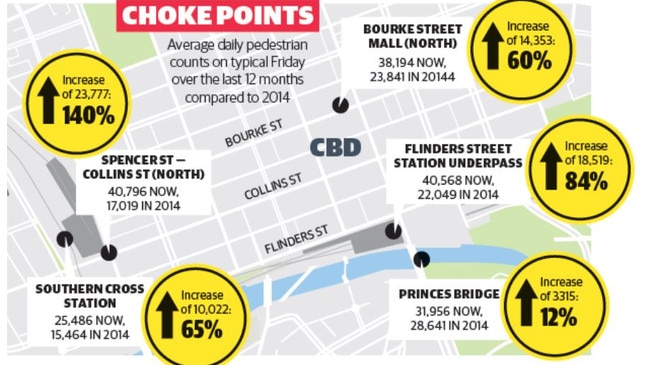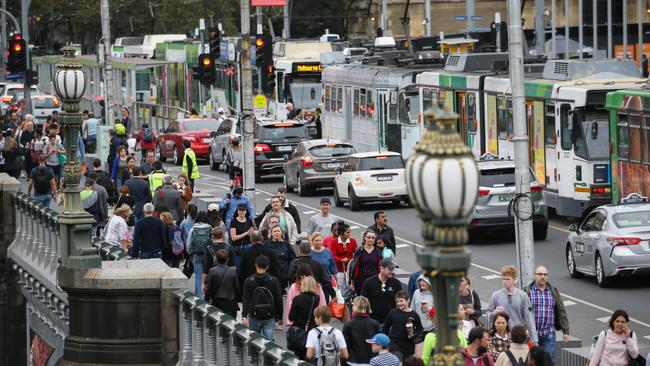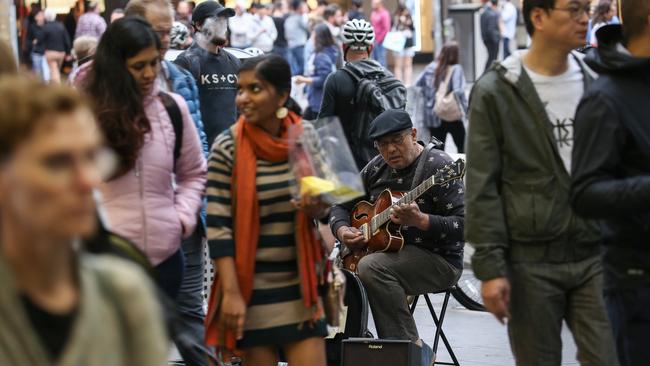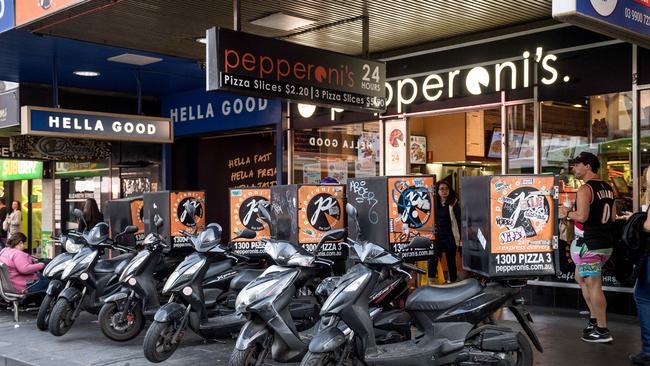New analysis reveals how overcrowded Melbourne’s CBD footpaths are
Pedestrian count data collected by the City of Melbourne shows key parts of the CBD are being inundated with an unprecedented jump in foot traffic. Here are the CBD’s worst spots and the bold plans touted to fix the overcrowding.

VIC News
Don't miss out on the headlines from VIC News. Followed categories will be added to My News.
Footpaths in Melbourne’s CBD are being pushed to capacity with 145,000 more people a day flooding the city compared with a decade ago.
Overcrowded streets have become a make or break issue as authorities float bold plans including closing down streets.
A Sunday Herald Sun analysis reveals pedestrian numbers have more than doubled at some choke points.
NEW BRIDGE TO CREATE GREEN TRAIL FOR CBD
AFL SPARKS FURORE OVER ANZAC DAY CLASH
WHY MELBOURNE’S IS BOOMING POPULATION BOOMING
Pedestrian count data collected by the City of Melbourne shows key parts of the CBD are being inundated with an unprecedented jump in foot traffic.
On average, more than 23,000 extra pedestrians are passing the corner of Spencer and Collins streets on a typical Friday than there were five years ago.
Other hot spots for growth include sensors at Southern Cross Station, Princes Bridge and the underpass beneath Flinders Street Station.
The corner of Flinders La and Swanston St has become one the busiest parts of the city for foot traffic and on a typical Friday records more than 49,000 pedestrians.
The total daily population of the CBD has risen from 766,000 in 2009 to at least 911,000 today.


Lord Mayor Sally Capp said the figure would surge to 1.4 million by 2036 with reducing pedestrian overcrowding a major priority.
“Within the central city 89 per cent of all trips occur on foot, however only 26 per cent of the street space in the Hoddle Grid is allocated to footpaths,” she said.
“We’re in the process of developing a transport strategy as part of the long term planning for our great city.
“Through our consultation and discussion paper phase, we’ve looked at a range of ways to improve transport modes, including improving pedestrian and cycling infrastructure.
“We are also looking at how we can encourage vehicles to come into the city only if it’s their end destination, rather than using the city as a thoroughfare, so we can help relieve traffic congestion.”
In a recent City of Melbourne survey more than half of respondents said they had experienced overcrowding on footpaths.
The council has floated a range of solutions ahead of the release of its new transport strategy including more car-free zones similar to the Bourke St Mall and improved crossing times at intersections.
Victoria Walks executive officer Dr Ben Rossiter said the city’s footpaths were increasingly congested.

“It is getting worse and it is going to get a lot worse,” he said.
“There’s clutter on the footpaths and we need to get rid of things like motorbikes and unnecessary signage.
“We’ve also got to start addressing big issues … The state government has to come to the party and work with the city by investing in pedestrian access.
“The first thing they should do is start funding some trial street closures and footpath extensions.”
Dr Rossiter said key public transport stops were choke points.
“The bottom of Bourke St could be closed immediately because people can’t get off tram stops.
“Our busiest crossing is Federation Square to Flinders Street station and seniors walking on the road don’t have enough green light time to get to the other side of the road.
“We also think the construction industry should be paying a levy to close footpaths because it would encourage them to only do it when necessary.”

Chantel Streeter, of Langwarrin said she regularly came to the CBD with her two daughters.
“Buskers, and the lack of splits or arrows on the footpath to encourage direction and flowing crowds can sometimes makes things difficult … you have to keep a close eye on the kids as you manoeuvre through all the people,’’ Ms Streeter said.
“I don’t like having the girls coughing when we have to walk through crowded areas and clouds of smoke.”
Buskers taking up too much of the footpath are among issues in the city council’s sights.
Its latest handbook for buskers stipulates they are responsible for ensuring pedestrian access is maintained.
They must also publicly announce their performance and direct crowds to ensure there is still access to essential clearances.
The council has also decommissioned nine large kiosks to improve flow for walkers and expanded the forecourt underneath the Flinders Street Station clocks.


